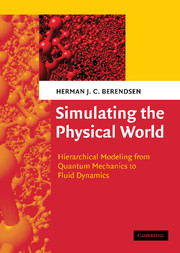Book contents
- Frontmatter
- Contents
- Preface
- Symbols, units and constants
- Part I A Modeling Hierarchy for Simulations
- 1 Introduction
- 2 Quantum mechanics: principles and relativistic effects
- 3 From quantum to classical mechanics: when and how
- 4 Quantum chemistry: solving the time-independent Schrödinger equation
- 5 Dynamics of mixed quantum/classical systems
- 6 Molecular dynamics
- 7 Free energy, entropy and potential of mean force
- 8 Stochastic dynamics: reducing degrees of freedom
- 9 Coarse graining from particles to fluid dynamics
- 10 Mesoscopic continuum dynamics
- 11 Dissipative particle dynamics
- Part II Physical and Theoretical Concepts
- References
- Index
5 - Dynamics of mixed quantum/classical systems
Published online by Cambridge University Press: 05 June 2012
- Frontmatter
- Contents
- Preface
- Symbols, units and constants
- Part I A Modeling Hierarchy for Simulations
- 1 Introduction
- 2 Quantum mechanics: principles and relativistic effects
- 3 From quantum to classical mechanics: when and how
- 4 Quantum chemistry: solving the time-independent Schrödinger equation
- 5 Dynamics of mixed quantum/classical systems
- 6 Molecular dynamics
- 7 Free energy, entropy and potential of mean force
- 8 Stochastic dynamics: reducing degrees of freedom
- 9 Coarse graining from particles to fluid dynamics
- 10 Mesoscopic continuum dynamics
- 11 Dissipative particle dynamics
- Part II Physical and Theoretical Concepts
- References
- Index
Summary
Introduction
We now move to considering the dynamics of a system of nuclei and electrons. Of course, both electrons and nuclei are subject to the laws of quantum mechanics, but since nuclei are 2000 to 200,000 times heavier than electrons, we expect that classical mechanics will be a much better approximation for the motion of nuclei than for the motion of electrons. This means that we expect a level of approximation to be valid, where some of the degrees of freedom (d.o.f.) of a system behave essentially classically and others behave essentially quantum-mechanically. The system then is of a mixed quantum/classical nature.
Most often the quantum subsystem consists of system of electrons in a dynamical field of classical nuclei, but the quantum subsystem may also be a selection of generalized nuclear coordinates (e.g., corresponding to high-frequency vibrations) while other generalized coordinates are supposed to behave classically, or describe the motion of a proton in a classical environment.
So, in this chapter we consider the dynamics of a quantum system in a non-stationary potential. In Section 5.2 we consider the time-dependent potential as externally given, without taking notice of the fact that the sources of the time-dependent potential are moving nuclei, which are quantum particles themselves, feeling the interaction with the quantum d.o.f. Thus we consider the time evolution of the quantum system, which now involves mixing-in of excited states, but we completely ignore the back reaction of the quantum system onto the d.o.f. that cause the time-dependent potential, i.e., the moving nuclei.
- Type
- Chapter
- Information
- Simulating the Physical WorldHierarchical Modeling from Quantum Mechanics to Fluid Dynamics, pp. 109 - 138Publisher: Cambridge University PressPrint publication year: 2007



